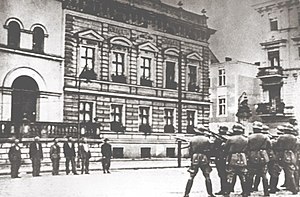
Back القضاء على المثقفين Arabic Intelligenzaktion Azerbaijani Intelligenzaktion Czech Intelligenzaktion German Ιντελιγκέντσακτιον Greek Intelligenzaktion Esperanto Intelligenzaktion Spanish Intelligenzaktion Basque اینتلیگنتساکتسیون Persian אקציית האינטליגנציה HE
| Intelligentsia mass shootings | |
|---|---|
| Part of Generalplan Ost and Nazi crimes against the Polish nation | |
 In occupied Poland, on 9 September 1939, the Germans publicly executed twenty-five prominent citizens, before the Municipal Museum, in the Market Square of Bydgoszcz, as part of the mass shootings of Polish intelligentsia.[1][2] To terrorise the townsfolk, the Germans displayed the bodies for six hours.[3] | |
| Native name | Intelligenzaktion |
| Location | Occupied Poland |
| Date | 1939–1940 |
| Target | Poles (teachers, priests, intellectuals, civic officials, and the upper classes) |
Attack type | mass murder, mass shooting, Genocidal massacres |
| Weapons | Automatic weapons and small arms |
| Deaths | 100,000[4] (61,000 from lists) [5] |
| Perpetrators | SiPo, Kripo, Gestapo, SS, Wehrmacht, Nazi Party |
| Motive | Consolidation of Nazi control of Poland, Germanisation, Anti-Polish sentiment |
The Intelligenzaktion (German pronunciation: [ɪntɛliˈɡɛnt͡s.akˌt͡sjoːn]), or the Intelligentsia mass shootings, was a series of mass murders which was committed against the Polish intelligentsia (teachers, priests, physicians, and other prominent members of Polish society) early in the Second World War (1939–45) by Nazi Germany. The Germans conducted the operations in accordance with their plan to Germanize the western regions of occupied Poland, before their territorial annexation to the German Reich.
The mass murder operations of the Intelligenzaktion resulted in the killing of 100,000 Polish people; by way of forced disappearance, the Germans imprisoned and killed select members of Polish society, identified as enemies of the Reich before the war; they were buried in mass graves which were dug in remote places.[4] In order to facilitate the depopulation of Poland, the Germans terrorised the general populace by carrying out public, summary executions of select intellectuals and community leaders, before they effected the expulsion of the general population from occupied Poland. The executioners of the Einsatzgruppen death squads and members of the local Volksdeutscher Selbstschutz, the German-minority militia, justified their actions by falsely stating that the purpose of their police-work was to remove politically dangerous people from Polish society.[4]
The Intelligenzaktion was a major step towards the implementation of Sonderaktion Tannenberg (Special Operation Tannenberg), the installation of Nazi policemen and functionaries — from the SiPo (composed of Kripo and Gestapo members), and members of the SD — to manage the occupation and facilitate the realization of Generalplan Ost, the German colonization of Poland.[6] Among the 100,000 people who were killed in the Intelligenzaktion operations, approximately 61,000 of them were members of the Polish intelligenzia, people who the Germans considered political targets according to the Special Prosecution Book-Poland, a book which was compiled before the war began in September 1939.[5] The Intelligenzaktion occurred soon after the German invasion of Poland (1 September 1939), and lasted from the autumn of 1939 until the spring of 1940; the mass murder of the Polish intellectuals continued with the operations of the AB-Aktion.[7]
- ^ Jerzy Ślaski, Polska walcząca, vol. 2, 3rd ed., augm., Warsaw, Oficyna Wydawnicza Rytm, 1999, p. 554. ISBN 8387893315.
- ^ Janusz Kutta, "Rola Kościoła katolickiego w dziejach Bydgoszczy" (The Role of the Catholic Church in the History of Bydgoszcz), Kronika Bydgoska, vol. 19, ed. W. Jastrzębski, et al., Bydgoszcz, Towarzystwo Miłośników miasta Bydgoszczy, 1998, p. 14. ISSN 0454-5451.
- ^ Ryszard Wojan, Bydgoszcz: niedziela 3 września 1939 r., Poznań, Wydawnictwo Poznańskie (Towarzystwo Rozwoju Ziem Zachodnich. Rada Okręgu Bydgoskiego w Toruniu), 1959, p. 68.
- ^ a b c Wardzyńska 2009, pp. 8–10, 295.
- ^ a b Dr. Jan Moor-Jankowski, Holocaust of Non-Jewish Poles During WWII. Archived 16 May 2016 at the Wayback Machine Polish American Congress, Washington.
- ^ Prof. Dietrich Eichholtz (2004), »Generalplan Ost« zur Versklavung osteuropäischer Völker. Archived 24 June 2008 at the Wayback Machine PDF file, direct download 74.5 KB.
- ^ Tadeusz Piotrowski, Poland's Holocaust: ethnic strife, collaboration with occupying forces and genocide in the Second Republic, 1918-1947, McFarland, 1998, p. 25.
© MMXXIII Rich X Search. We shall prevail. All rights reserved. Rich X Search